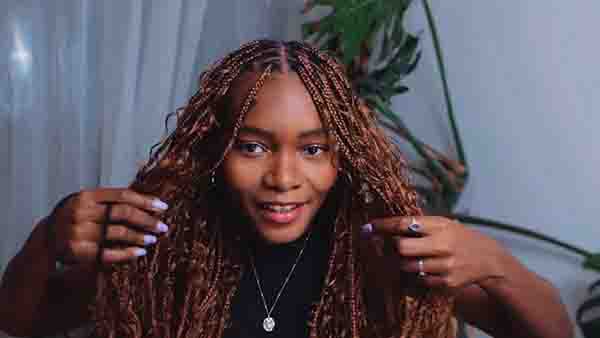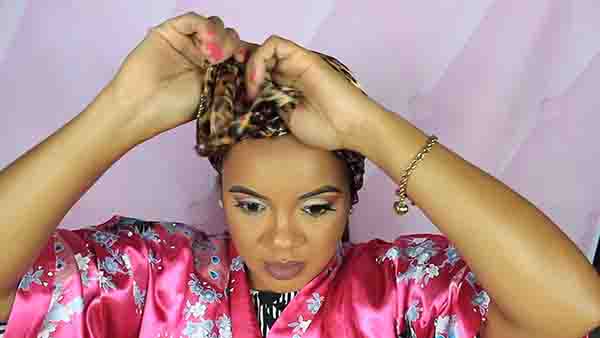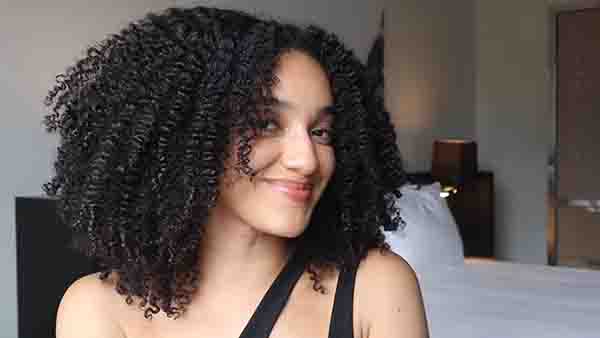To sleep with a braid out, secure your hair in a loose braid before bed. Getting a braid out hairstyle is a great way to switch up your look, but the question remains: how do you preserve it while you sleep?
We all know the struggle of waking up with flattened, frizzy hair after a good night’s rest. That’s why it’s important to know the proper technique for sleeping with a braid out. By following a few simple steps, you can ensure that your braid out hairstyle stays intact and ready to flaunt the next day.
We’ll discuss tips and tricks to help you sleep comfortably while also maintaining your gorgeous braid out. Whether you have short, medium, or long hair, these methods will work for you. So, let’s dive in and learn how to keep your braid out looking fresh and fabulous!
Sleeping in Braids: A Game-Changer for Hair Health and Convenience

Sleeping in braids can be a game-changer for your hair care routine, offering both time-saving benefits and improved hair health. Here’s why adopting this method can enhance your overall style and well-being:
1. Time-Saving Solution
Mornings can be hectic, and dealing with unruly hair can add unnecessary stress to your routine. Sleeping in braids allows you to wake up with pre-styled hair, saving you precious morning minutes. Your braids don’t need to be perfect; they can be protected with a scarf or bonnet, making them ready for styling in the morning.
2. Hair Health
Sleeping in braids can help protect your hair from friction and reduce tangling and breakage. By keeping your hair contained in braids overnight, you minimize the risk of hair strands rubbing against your pillowcase and becoming tangled. This gentle approach to hair care promotes overall hair health.
3. Comfort and Adjustment
If your braids feel too tight and cause discomfort, sleeping in them allows for gradual loosening. This means you can adjust the tightness to a level that is comfortable for you. Loose braids can still maintain their shape and texture, making them a versatile choice for overnight styling.
4. Silk Pillowcase Benefits
Adding a silk pillowcase to your nighttime routine provides additional advantages. Silk is gentle on your hair and skin, reducing friction that can lead to frizz and breakage. A silk pillowcase can help preserve the texturized, smooth appearance of your braids, ensuring they look their best in the morning.
5. Simple and Savvy Hair Care
Sleeping in braids is a simple and savvy hair care method that offers multiple benefits simultaneously. It allows you to maintain a stylish look while prioritizing the health and well-being of your hair.
How do you sleep in braids without ruining them

Sleeping with braids can be challenging, especially when you want to keep them neat and intact. This guide helps you navigate this hurdle. Here’s how you go about it:
- Secure your braids with a hair-safe elastic or scrunchie. Avoid using anything that might snag or damage your hair.
- Loosen tight braids before going to sleep to avoid discomfort and possible hair loss.
- Sleep on a silk or satin pillowcase to prevent tangles and knots.
- Remember to apply a leave-in conditioner or hair oil before bedtime to keep your hair moisturized.
- If you have a sensitive hairline, consider using a soft headband or scarf for protection.
- Lastly, proper security for your braids helps maintain your hairstyle and prevent tangles or frizz.
What happens if you leave your hair in a braid overnight

Keeping your hair in a braid overnight can help maintain your hairstyle and create lovely waves It also helps to prevent tangles and knots. Braiding your hair at night can also help to reduce frizz and make it easier to style in the morning.
One of the primary advantages of braid-outs is their ability to create the illusion of longer hair. This is especially beneficial for individuals with tight curls, as these curls can sometimes appear shorter due to their coiled nature. Braid-outs work by elongating these curls, resulting in a longer and more stretched-out appearance.
Promoting the Appearance of Longer Curl Patterns
For those with tight curls, the braid-out style can be particularly effective in promoting the appearance of longer curl patterns. When you release the braids, your hair takes on a wavier and more stretched-out look. This not only enhances your hair’s style but also gives the impression of increased hair length.
Temporary Transformation for Styling
It’s essential to understand that the elongation effect achieved through braid-outs is temporary. While it doesn’t impact the actual rate of hair growth, it offers a versatile styling option that can make your hair look longer and more controlled when desired.
Reduced Frizz and Stray Hair
Another advantage of braid-outs is their ability to result in less frizziness and fewer stray hair strands, especially when styled on damp hair. The wavy pattern created by braid-outs tends to be more controlled and less susceptible to the effects of humidity and environmental factors. This contributes to a healthier appearance and can enhance the overall look of your hair.
Improved Manageability for Healthier Hair
By achieving a longer and more stretched-out appearance, braid-outs can also make your hair more manageable. This can lead to healthier hair practices, as it may reduce the need for excessive manipulation, detangling, and the use of heat styling tools. Healthier hair practices can indirectly support hair growth by minimizing damage and breakage.
A heatless curling technique using braids
Creating heatless curls with braids is a simple and effective method for achieving beautiful, natural-looking waves. Here’s a step-by-step guide:
Step 1: Start with Dry Hair
Begin with clean, dry hair. If your hair is freshly washed, make sure it’s completely dry before you start braiding. Damp hair may not hold the curls as well.
Step 2: Part Your Hair
Part your hair down the middle to create two equal sections. You can use a comb to ensure a straight and even part.
Step 3: Braid Each Section
Take one section of hair and begin braiding it from the roots to the tips. You can choose the size of the braids based on your desired curl size. Smaller braids will result in tighter curls, while larger braids will create looser waves. Repeat the process with the other section of hair.
Step 4: Secure with a Scrunchie
To avoid leaving marks or indentations on your hair, secure the ends of each braid with a scrunchie or hair-friendly elastic band. Make sure the scrunchie is not too tight to prevent pulling or breakage.
Step 5: Wrap in a Satin Scarf or Bandana
To protect your hair while you sleep and reduce friction that can cause frizz and breakage, wrap your braids in a satin scarf or bandana. Satin is a smooth material that minimizes friction, helping your curls stay intact.
Step 6: Adjust Braiding Technique
Keep in mind that the tighter your braids, the curlier your hair will be in the morning. If you want looser waves, create larger, less tightly braided sections. Experiment with different braid sizes to achieve your desired style.
Step 7: Sleep Comfortably
Go to sleep with your braids securely wrapped in the satin scarf or bandana. Make sure it’s comfortable to sleep in, as you’ll want a good night’s rest.
Step 8: Morning Unveil
In the morning, carefully unravel the braids one by one. Avoid rushing or pulling, as this can disrupt the curl pattern. Instead, gently separate the curls with your fingers to create volume and achieve the desired look.
Get the Right Tools and Products for Your Braid Out

Maintaining your braid-outs overnight is crucial for preserving the style and keeping your natural hair looking its best. To achieve this, you’ll need the right tools and products. Let’s take a closer look at each item and its pros and cons:
1. Silk Bonnet/Scarf:
- Pros: Keeps your hairstyle intact and hydrated, minimizes friction and frizz, and protects your hair from breakage.
- Cons: Some individuals may find it uncomfortable to sleep with a bonnet or scarf on.
2. Natural Hair Braid-out Oil:
- Pros: Helps maintain moisture, prevents tangles, and adds shine to your curls, keeping them well-defined.
- Cons: Some oils may stain pillowcases, so it’s important to use them sparingly.
3. Briogeo’s Curl Charisma Rice Amino + Avocado Hydrating Shampoo and Conditioner:
- Pros: Nourishes your hair, maintains moisture, and supports overall hair health.
- Cons: These products may be more expensive compared to average hair care products, but they offer specific benefits for natural hair.
4. Mizani’s 25 Miracle Nourishing Oil:
- Pros: Helps with un-braiding by reducing friction between strands, making it easier to separate your curls.
- Cons: Some people may find that it leaves their hair feeling greasy, so use it sparingly.
5. Ouidad’s Coil Infusion Good Shape Defining Gel:
- Pros: Provides a frizz-free finish, helps maintain curl definition, and adds hold to your style.
- Cons: Continued use may lead to product buildup on your hair, so be mindful of the amount you apply.
Prep Your Hair for a Braid Out
1. Hydrate Your Hair:
Begin with clean, damp hair. You can achieve this by taking a quick shower or using a spray bottle to evenly wet your hair. Hydrated hair is more pliable and receptive to products.
2. Apply Your Chosen Product:
Select a hair product that suits your hair type and texture. Options include leave-in conditioners, hair oils, or styling creams. While applying the product, make sure to detangle your hair gently. It’s important not to overdo it with the product, as excessive product can lead to longer drying times.
3. Section Your Hair
Divide your hair into even sections. The number of sections will depend on your hair’s thickness and the desired curl or wave size. Keep in mind that tighter braids result in more defined curls, while looser braids create softer waves.
4. Start Braiding
Begin the braiding process on each section of your hair. You can choose from various braid types, such as three-strand braids, two-strand twists, or any other preferred braiding technique. The key is to braid tightly for well-defined curls or more loosely for gentle waves.
5. Drying Your Hair:
- Option 1 – Overnight: To minimize frizz and get the best results, allow your hair to air-dry overnight. Protect your hair by covering it with a silk scarf or bonnet as you sleep.
- Option 2 – Hairdryer: If you prefer a quicker drying method, use a hairdryer with a diffuser attachment. Ensure that your hair is completely dry before moving on to the next step.
6. Untie Your Braids:
Once your hair is fully dry, carefully undo your braids, starting from the ends and working your way up to the roots. Avoid rushing this step to prevent unwanted frizz.
7. Fluff and Style:
Use your fingers to gently separate the curls or waves and create the desired volume and shape. You can also use a wide-tooth comb or pick to fluff and define your hair. If needed, apply a light-hold hair spray or oil for added shine and hold.
Choose the Right Braids for Your Hair Type
Creating the perfect braid-out hairstyle involves considering your hair type, choosing the right braid style, prioritizing comfort, and using quality hair ties. Here’s a breakdown of these essential considerations:
1. Hair Type:
Tailor Your Approach to Your Hair’s Characteristics
Thin or Straight Hair: For individuals with thin or straight hair, starting with slightly damp strands can help the curls hold longer. This slight moisture adds some weight and encourages the curls to take shape.
Thicker or Curly Hair: If you have thicker or naturally curly hair, you may not need as much moisture. You can apply your chosen styling product to dry hair for defined curls.
2. Braid Style:
Choose the Right Braiding Technique for Your Desired Look
Number of Braids: The number of braids you create will impact the final result. More braids will give you curlier hair, while fewer braids will result in looser waves.
Braid Tightness: The tightness of your braids also matters. French braids or tightly woven braids will give you crimped hair, while looser braids result in softer waves.
3. Comfort Matters:
It’s crucial to ensure that the braids are not too tight. Tight braids can lead to scalp tension, discomfort, and even hair breakage. Choose a level of tension that is comfortable for you.
4. Quality Hair Ties
Opt for hair ties that are gentle on your hair. Avoid rubber or elastic bands with metal parts, as they can snag and damage your hair. Instead, use hair-safe elastic bands or soft scrunchies that won’t cause breakage.
Know How Long to Leave Your Braid Out
Your braid out on natural hair typically lasts for a solid 5 to 7 days, if made and preserved well. Here are a few tips to ensure it stays fresh:
1. Slow Drying for Defined Curls
Opt for a slow drying process to achieve well-defined curls that can last longer. This can involve air-drying or using a hooded dryer on a low heat setting.
Properly dried and set braids will lead to more defined and enduring curls. Take your time during the drying process to ensure that your hair sets properly.
2. Protect Your Braid-Out at Night:
Before going to bed, safeguard your braid-out by wrapping your hair in a silk scarf or wearing a silk du-rag. This nighttime protection helps prevent friction, frizz, and disturbance to the style.
Silk is gentle on the hair and minimizes moisture loss, allowing your curls to stay intact.
3. Consistent Moisturizing:
Maintain your braid-out by using appropriate moisturizing products throughout the week. Apply a leave-in conditioner or hair oil to keep your hair hydrated and prevent dryness or frizz.
Consistent moisturizing helps your curls look fresh and well-defined.
FAQ
To preserve your braid out overnight, consider wrapping your hair in a silk or satin scarf or bonnet. You can also lightly re-braid the braids to help maintain the style.
Sleeping with fresh braids is best done by wearing a satin or silk scarf or bonnet to protect the braids and prevent frizz. Alternatively, you can gently re-braid the braids to maintain their shape.
Yes, you can sleep in a loose braid if it’s comfortable for you. A loose braid may help maintain some of the wave or curl pattern in your hair while preventing excessive frizz.
The drying time for a braid out can vary depending on your hair type, the size of the braids, and the level of moisture in your hair. It may take a few hours to overnight for your hair to fully dry.
For braid outs, you can use products like leave-in conditioners, styling creams, or hair oils to add moisture and hold to your hair. Experiment with different products to find what works best for your hair type.
Both braid outs and twist outs are natural hair styling techniques, but they differ in the way the hair is manipulated. Braid outs involve braiding sections of hair, while twist outs involve twisting sections of hair. The resulting textures and patterns are slightly different.
To make your braids last all day, avoid excessive manipulation, and use styling products that provide hold and control frizz. Consider using a hairspray or hair gel with a soft hold.
The longevity of a twist out can vary depending on factors like your hair type and the products used. On average, a well-maintained twist out can last 3-5 days.
Overnight braid curls can last throughout the day if you’ve allowed your hair to dry fully before unraveling the braids. To extend their lifespan, protect your curls at night with a scarf or bonnet.
Protecting your braids while sleeping involves using a satin or silk scarf or bonnet to prevent frizz, tangling, and breakage. You can also loosely re-braid the braids to maintain the style.
To achieve a good braid out, it’s generally recommended to keep the braids in for at least 6-8 hours or overnight. This allows the hair to set and hold the desired texture.
You can leave your braids in before bed if you want to maintain the style. To prevent tangling and frizz, protect the braids with a satin or silk scarf or bonnet.
Sleeping in braids is not inherently damaging, but it’s essential to ensure the braids are not too tight, as excessive tension can lead to breakage. Using a protective covering like a satin or silk scarf or bonnet can help minimize friction and potential damage.
Braids can be a protective style that helps retain length by preventing breakage. However, hair growth primarily depends on genetics, diet, and overall hair care practices.
When taking out braids, avoid rushing the process, as it can lead to excessive hair breakage. Instead, gently unravel the braids, and use a detangling product or conditioner to help with the process.
It’s a good practice to let your hair breathe for at least a few days to a week between protective styles like braids. This allows your scalp and hair to rest and recover.
You can take braids out whenever you’re ready for a style change. However, it’s essential to do so gently to minimize hair breakage.
The freshness of braids can vary depending on factors like the installation quality, your hair type, and how well you maintain them. On average, braids can look fresh for 4-8 weeks.
Whether you choose to sleep in braids or a bun depends on your hair type and personal preference. Both can be protective styles, but buns may cause less friction than loose braids.
Sleeping with your hair down may lead to tangling and friction, while sleeping in braids can help protect your hair and style. It ultimately depends on your hair type and desired outcome.
To wake up with good-looking hair, consider protecting it with a satin or silk scarf or bonnet while sleeping. This helps prevent frizz and maintain your hairstyle.
Braids themselves aren’t inherently damaging, but damage can occur if they’re installed too tightly or if you neglect proper care while wearing them. To minimize damage, avoid excessive tension during installation and maintain a healthy hair care routine.
Loose braids are generally gentler on your hair than tightly woven ones. They reduce the risk of breakage and hair loss. However, excessively loose braids may not retain the style well or provide as much protection. Striking the right balance is key.
To prevent braids from frizzing, apply anti-frizz products, like serums or oils, to your braids. Additionally, use a satin or silk scarf or bonnet at night to protect your braids while sleeping, reducing friction and frizz.
Verdict
We hope you enjoyed this article on how to sleep with a braid out! As you can see, there are a few different ways to do it, and it really depends on your personal preference. Just remember to be gentle with your hair, use a silk scarf or pillowcase, and don’t forget to moisturize!

